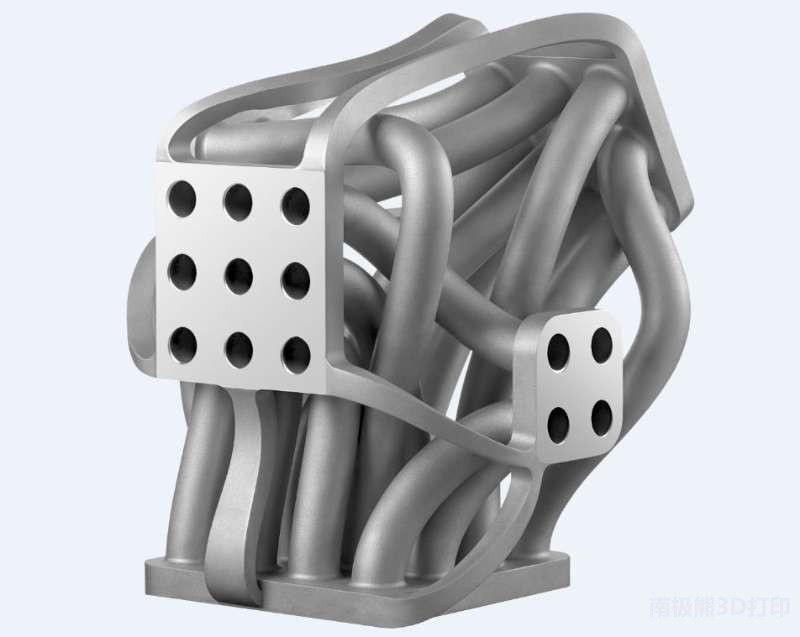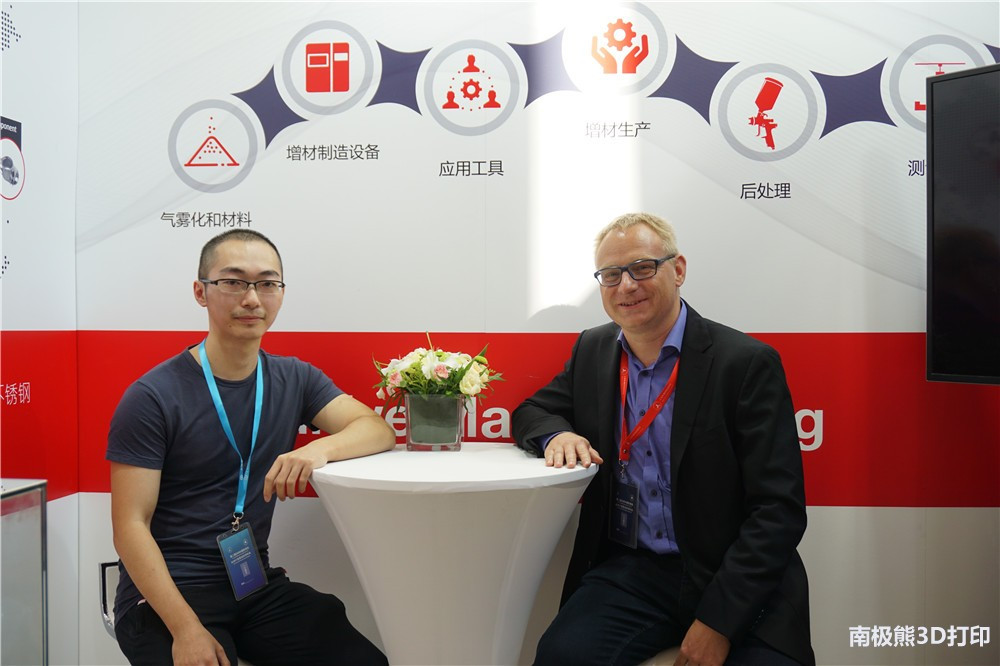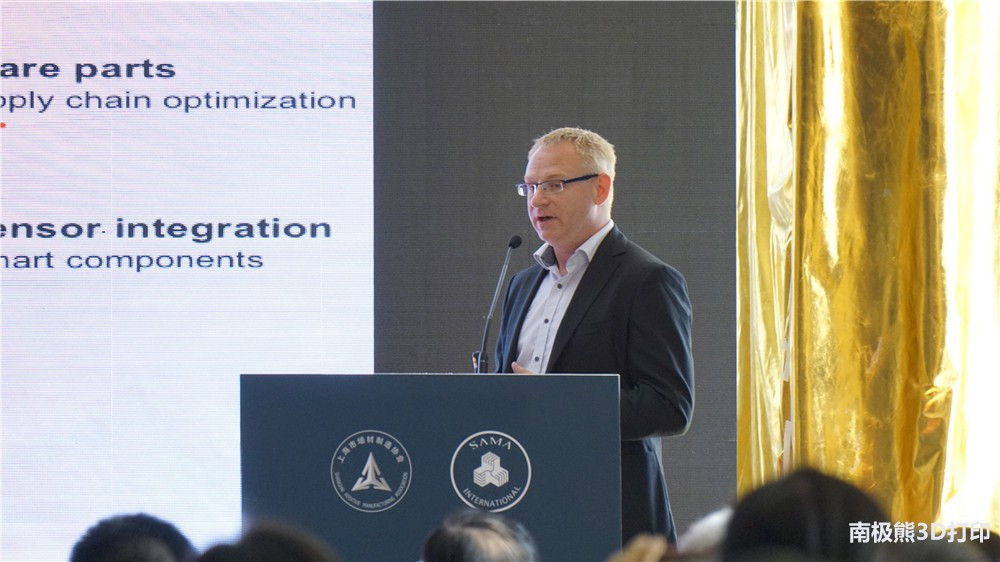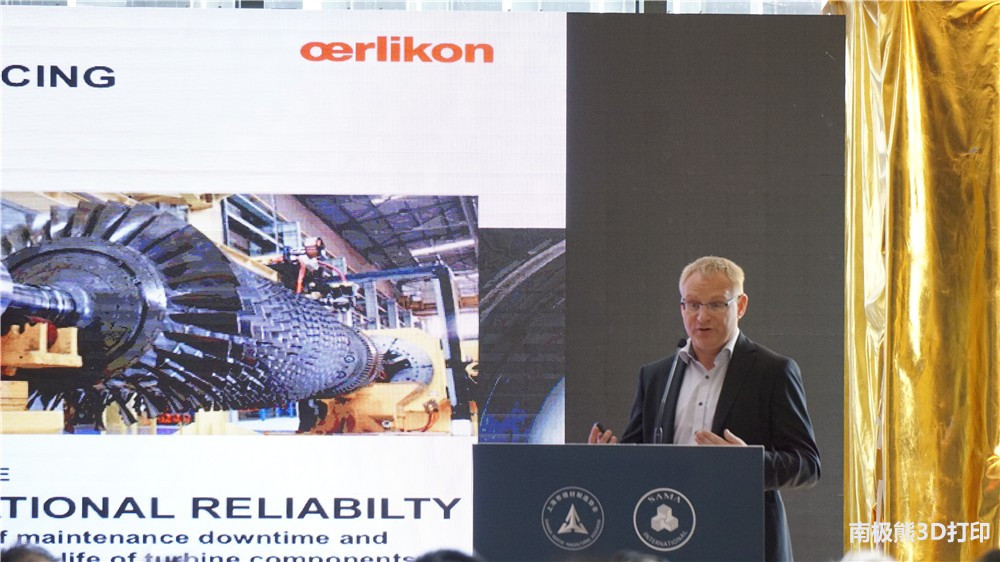欧瑞康(Oerlikon)是一家有百年历史的瑞士企业,是世界上较具创新力的工业集团之一。欧瑞康在2016年底宣布将在美国密歇根州新建一座先进材料工厂,专门生产增材制造金属粉末和高端的表面涂层材料;随后在2016年12月,欧瑞康收购了德国领先的金属增材制造服务公citim,并在2017年年初奠基在美国北卡罗琳娜州新建高端增材零部件生产制造工厂,并计划于2018年在中国成立零部件打印服务中心,进一步深化了欧瑞康在全球增材制造市场的战略布局。

△欧瑞康金属粉末打印的分配器壳体
欧瑞康在金属增材制造产业有怎样的布局?为什么选择在这个时候进军中国市场?带着这些问题,南极熊于2017年10月21日对citim联合创始人及欧瑞康增材制造欧洲制造业务负责人Andreas Berkau先生进行了专访。在上海临港松江科技城双子楼,我们就当前金属3D打印市场的全球格局以及citim在金属3D打印发展进程中的角色进行了深度探讨。

△AndreasBerkau(右)与南极熊(左)
以下是专访对话全文。
南极熊:首先请允许我介绍一下自己。我来自中国最大的3D打印媒体平台之一——南极熊。今天我很荣幸能够采访您。能否给我们一个简短的自我介绍以及你与Citim和Oerlikon的关系?
Andreas Berkau:我叫Andreas Berkau,我毕业于马格德堡大学生产技术专业,之后我加入了刚刚成立的Citim公司,所以我有机会成为这家公司的第一名员工,之后又成为该公司的一名股东。而这家公司在刚起步的时候就专注于快速成型技术,主要生产汽车行业的零件。所以我有机会接触到最早的激光设备,并对它们的兴趣浓厚。
后来公司的战略方向开始逐渐转向增材制造,于是我们从2004年开始使用第一台基于塑料材料的3D打印设备,2009年随着第一台金属3D打印设备的应用,我们公司开始逐渐从一家原型设计公司转型升级为一家增材制造服务公司,不久后也在美国设立了一家金属3D打印的工厂。就在去年年底(2016年)Citim被欧瑞康收购。这是因为全球增材制造市场的迅速扩张,我们也要开始考虑为公司的工业化发展走好下一步。
南极熊:您的客户在全球范围内来自于哪些工业领域?
Andreas Berkau:我认为Citim在汽车行业有很强大的背景,这也是作为一家德国公司的传统。但是随着增材制造行业的发展,我们也在航空航天,能源,工业,医疗有很多应用。

△欧瑞康在SAMA大会上展示的金属打印件
南极熊:在所有工业领域中,您认为最有前景的领域是什么?
Andreas Berkau:我认为是航空航天。因为你可以在航空航天领域找到很多的应用案例。医疗行业也是非常有前景的。我们为客户提供增材制造的解决方案的过程中,其中一个主要问题是零件的成本居高不下。我认为如果这个问题能够得到解决的话,那么更多的工业零部件可以得益于3D打印技术。虽然我们现在能够在工业、能源和汽车行业找到很多3D打印的案例,但是如果解决了成本问题,我们运用3D打印技术的机会会有爆发式的增长。
南极熊:2014年开始,中国开始出现好多家金属3D打印公司,并且每年都在增长。欧瑞康选择这个时候进军中国市场,您认为其优势体现在哪些方面?
Andreas Berkau:我认为欧瑞康的最大优势在于我们不仅仅是3D打印服务提供商,我们关注的是整个3D打印产业端到端的价值链。
公司的业务重点首先是金属粉末材料。欧瑞康是金属粉末制造商,在这个领域有非常丰富的经验。另外我们不仅仅是打印单独的零部件,而是关注于整个零部件的生产制造工艺流程。这就意味着我们需要整合一整套的后处理工序。收购Citim是欧瑞康进军增材制造事业的战略布局第一步,我们有着丰富的经验并且能够灵活应用。凭借着这种一整套的生产制造链,我认为欧瑞康在市场上具有独特的地位。
南极熊:您认为目前阻碍金属3D打印产业的因素有哪些?
Andreas Berkau:我认为有很多。相比其它的传统制造产业,金属3D打印是一种全新的技术,所以行业中还没有权威的制定标准。有时候遇到产品质量表面不合格的情况,这也是由于技术不成熟的原因导致的。因此你就要必须保证产品在其生产周期中,它们的质量稳定性和一致性。
另外我认为未来的一大挑战是我们如何培养设计师,让他们发掘3D打印在工业应用上的潜力。传统的制造思维与3D打印格格不入。为产品找到正确的三维设计方案很重要,然而现在很多设计师缺乏3D打印的设计理念和经验。你当然可以通过传统制造方式来制造产品,但是如果你能够找到3D打印技术的可能性,你就能摆脱传统思维的限制,开辟巨大的设计空间,创造出全新的、传统思维难以制造的产品。
当然我们面临的挑战不止这些,现阶段的设备昂贵、生产效率不够理想。在未来如果价格能够降下来,我相信这个产业会有更多的机会出现。

△欧瑞康在SAMA大会上展示的金属打印件
南极熊:您刚才提到成本问题,成本下降是一个过程。您认为这个过程还需要多久?
Andreas Berkau:我认为其中一个主要因素是设备成本。如果设备的供应量增加市场就有希望把价格降下来。另外一个方面,我看到近几年越来越多的新技术出现,比如惠普也开始凭借他们独特的技术信心满满地进军3D打印市场,这些都有可能推动3D打印行业的发展并降低成本。
南极熊:最后一个问题。您对未来的金属3D打印的发展有何预期?
Andreas Berkau:从全球范围来看,我认为金属3D打印产业才刚刚开始。由于是一门全新的技术,在很多工业应用中它都无法与传统制造方式抗衡,但我相信它将来在制造业中会具有举足轻重的地位。如果你有机会在这种技术发展的早期切入这个产业,那么将来你一定会成为这个行业的领军者。
第二届SAMA国际论坛上,Andreas Berkau先生发表重要演讲。演讲主题:金属增材制造在工业燃气轮机和汽车领域的应用和发展趋势。


关于citim
创建于1996年的citim是从德国马格德堡大学分离出来的一家公司。citim是增材制造金属部件的领先供应商,主要为航空航天、能源、医药和汽车行业提供服务。2004年citim发布激光烧结技术,并于2009年将激光熔化技术推向市场。2016年,瑞士欧瑞康集团完成了对citim的收购。
英文专访录音原文
Nanjixiong: First please allow me to introduce myself. I'mfrom Nanjixiong which is China's biggest 3D printing media platform.
It is my honourtoday to give you an interview. Let's start with the first question. Could you give us a brief self-introductionof yourself and your relationship with citim and the Oerlikon?
Andreas Berkau: Yeah of course. My name is Andreas Berkau. My background, I'm a mechanical engineer. Igraduated from University of Magdeburg and after that I had a chance to join citim,which was founded at this time and so I had a chance to be the first employeein this company and later to one of the shareholders of this company. And this company was focused at the beginningon rapid prototyping, mainly to produce parts for example automotive industry. SoI had a chance to work with one of the first laser machines. It was fascinatingfor me. It was a basic idea to installsome 3D printing equipment in the company. And we started in 2004 with the first plastic machines, 2009 with thefirst metal machines and it changed a little from a prototyping company to anadditive manufacturing company and then as well we opened a facility in the USjust for printing 3D printing metal. Andat the end of last year, citim was acquired from Oerlikon because as the marketfor additive manufacturing changed dramatically and so and definitely we haveto go the next step in our industrialisation.
Nanjixiong: What industrial areas areyour customers coming from in global?
Andreas Berkau: I think citim has a strong background inautomotive industry because as a German company we always have a strongbackground in our automotive. But with additivemanufacturing that changed as well to aero space, energy, general industry andof course some medical application.
Nanjixiong: Among all the industrial areas what do youthink is the most promising area ?
Andreas Berkau: Right now I think the most comes from aerospace,because you can already find some business cases in aerospace. I think medical as well. Because there are always some businesscases. But when we solve the mainproblems for additive manufacturing and one of the main problems is the cost ofthe parts. I think then you have accessto a lot more parts of areas of the industry. I think you can always find some applications in the general industry, Powergeneration as well as automotive. But itwill be much more when we have solved some price topics, Which will widen therange.
Nanjixiong: Since 2014 there are quite a lot of metal 3Dprinting companies founded in China. What do you think are the advantages ofOerlikon entering China market?
Andreas Berkau: I think the big advantage of Oerlikon is thatwe are not just a 3D printing provider. We are focusing on a whole value chain.
It starts with most importanttopic which is the materials. Oerlikon is a powder producer. I have a long time experience withmanufacturing powder materials. Itbrings experience with printing of components and in combination we’re not justprinting parts we are focusing on the component. That means the component is necessary forpost processing and do finishing and applying coding. With this kind of combinationI think Oerlikon has the unique position on the market.
Nanjixiong: Oerlikon is mainly focusedon the metal materials and the citim is mainly focused on the 3D printingservices.
Andreas Berkau: citim is a startingpoint, which is the nucleolus of the 3D printing activities from Oerlikon. We have the experience and we can transferthe experience. It comes all together, which is a good starting point to expandall activities.
Nanjixiong: What do you think are theobstacles that prevent the metal 3D printing in the global?
Andreas Berkau: There are somechallenges. I think the challenges are, one topic is it’s a brand newtechnology so there are not so many standards established in the industry. Thereare a lot of activities to establish some standards. Because this technology isbrand new. So you always have to be surethat you can produce the same quality over a lifetime of a product. So thereare some standards missing and I think quality is a key point. Of course, you do have some issues withsurface qualities sometimes but it’s a definitely a new technology to produceparts.
I think one of themain challenges in the future is we have to teach the designer aboutpossibilities that 3D printing can offer. Traditional thinking is not in 3Dprinting. So I think there is a lack ofknowledge for the designers and it is really important that you apply the rightdesign for parts. If you just doing aconventional design and try to print these parts of course it’s possible. But when you have the right design, I thinkthere is more possibilities to find new products and to design complete newcomponents. And of course there are someother challenges as well. Machines areexpensive and productivity is not so high. That means the costs for parts are really high and you have to find theright components today. It is possibleto find components but you have to pick up the right components. And in the future when the price comes downfor materials, for machines, and I think there are more opportunities.
Nanjixiong: You mentioned cost, how long do you thinkwill the cost in metal 3d printing industry coming down?
Andreas Berkau: That is a difficult question. Of course we produce parts, but as a mainquestion I think it is more related to the machine suppliers because they aremore able to reduce the price. I thinkto have, if you have more machines than market then we have scaling for themachine manufactures and then the machine price will come down. That is one topic and on the other hand yousee some new technologies coming to the market for printing as well metalparts. I think that maybe will have more speed in the future to decrease theprice. You can see the same right nowfor plastic parts since HP jumped into the market with a lot of promise. The speed for new developments will increase.And I see the same for metal.
Nanjixiong: So next question. What is your vision of this metal 3D printingin Europe?
Andreas Berkau: I think it’s more in theglobe because it’s a brand new technology and we are just starting. We have to exploreit. So right now it is interesting and fascinating but it is still aniche. I think my vision is that thistechnology will definitely be a standard technology in the future. For someapplications it will not compete with existing technologies but it is a newtechnology to produce parts and I think it will be established more or less inall industry in the future. That is whyI think this really small business when you look at the global scale I think itwill be a standard in the future for many industries. And I think there is a chance if you areearly in this industry and that you will be one of the leader in the future.
Nanjixiong: This is all my questions Ihave for today. Thank you very much.
Andreas Berkau: You are very welcome.